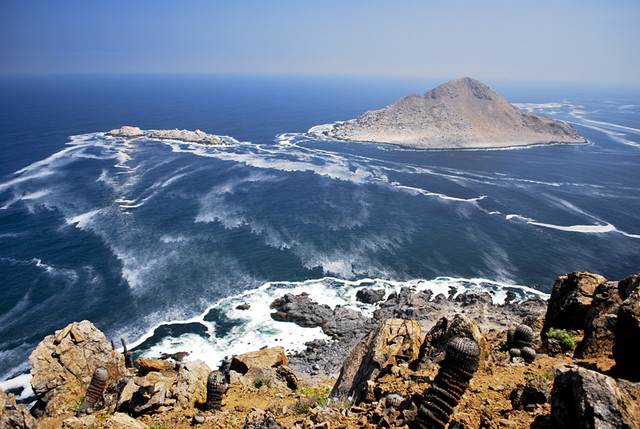NATIONAL PARKS III REGION
PAN DE AZÚCAR NATIONAL PARK
It is located at 30 km. northeast of Chañaral.
This park is characterized by a poorly developed littoral plain and a coastal cliff of 800 m. height above sea level, which is ran through by several ravines. Many beautiful sites can be sighted from this cliff, such as Las Lomitas, El Mirador and the interesting Humboldt Island, which is filled up with penguins.
The park has two beautiful beaches: Laguna Blanca and Los Piqueros.
This park shelters fauna both from maritime and arid continental ecosystems, such as chungungos, lobos de un pelo (a species of Chilean seal), guanacos, sea wolves (seals), “chilla” foxes and “culpeo” foxes. We can also find many bird species, such as regular eaglets, red-headed turkey buzzards, “blind” hens, swallows and pelicans. Among marine birds fauna, it is important to mention Humboldt penguins.
An information office, a museum, an exposition hall, and an environmental information center have been set up in the park by CONAF.
The Park also has a camping area, a mini-market, a restaurant, restrooms, and two lodging cabins.
Little port facilities can be found in the coastal area, where you can take boat excursions.
You can get to this place by taking a 30 km. coastal road from Chañaral until Pan de Azúcar Little Port. You can also take 5 Norte Pan-American Highway, and then C-110 road from the 1410 km.

LLANOS DEL CHALLE NATIONAL PARK
It is located at 40 km. northwest of Huasco.
This 45,708 hectares park was created as a scientific interest zone for mining purposes. It is situated in an ecological area of the coastal desert.
Specifically, it is located 60 km. from Vallenar by the road that leads to Carrizal Bajo, and 40 km. north of Huasco. It stretches all along the coastal mountains, the community of Huasco and Huasco Province.
It has a superficies of 45,708 hectares.
The flora corresponds mainly to dessert thickets. Up to date, 278 species have been registered. 16 cactaceous species are characterized by a highly endemic condition.
70 species constitute the typical fauna: 56 bird species, 9 mammal species, 4 reptile species and 1 amphibian species. 18% of these animals are currently endangered.
Birds constitute the most numerous group (80%). Guanaco, Guanicoe llama, vultur griphus condor, migratory hawk and the Atacama toad are the most common species of the zone.
The objective of this park is to protect flora and fauna typical species which are not protected by a conservation law, thus a protection decree was urgently passed.
NEVADO TRES CRUCES NATIONAL PARK
It is located at Copiapó s pre-Cordillera zone.
The 59,082 hectares Nevado Tres Cruces National Park has many natural attractions, such as Cordillera lakes, high mountain tops, and a great variety of animal species like 47 altiplano bird species.
The objective of this Park is the preservation of Andean ecosystems like Santa Rosa Lagoon, Maricunga Salt Deposit and Negro Francisco Lagoon. This more than 3,500 m. above sea level Andean ecosystem is a perfect place for native fauna to shelter, feed and breed.
Its 59,081. 87 hectares superficies is divided into two principal areas: Santa Rosa Lagoon and Maricunga Salt Deposit (46.944 hectares), and Negro Francisco lagoon (12,137 hectares).
In 1996, Santa Rosa and Negro Francisco lagoons were declared “Ramsar Sites”, i.e. humid soils under international concern for the conservation of aquatic birds. Chile received this nomination from the permanent committee of the Humid Soils Convention, Bern, Swiss.
The main access way is C-31 International Road, which connects Copiapó Province and Catamarca Province in Argentina. You can also take an additional road from Copiapó, which goes through Paipote Ravine until La Puerta. Then, it goes by Santa Rosa little port until the east side of Santa Rosa lagoon.
To access Negro Francisco lagoon, you can take any of the two roads mentioned in the last paragraph, until the southwest side of Maricunga Salt Deposit.
In the north side of Maricunga Salt Deposit there is a road leading to Pedernales Salt Deposit, which connects Potrerillos, El Salvador, Diego de Almagro and Chañaral towns.
Flora is characterized mainly by the presence of typical height vegetation (vegas and bofedales)
Salt deposits and lagoons shelter a diverse fauna: three species of flamingos, piuquenes, juarjual ducks, “pollitos de mar” and taguas. Among mammals, we can find: vicuñas, guanacos and culpeo foxes.
CONAF has two shelter cabins here. The first one, which offers potable water, kitchen, bedrooms and bathrooms, is located in the south side of Negro Francisco lagoon. The second cabin, which lacks of potable water and bathroom, is located in the west side of Santa Rosa lagoon.
THE ORBICULAR GRANITE NATURE SANCTUARY
It is located at 11 km. from Caldera.
It was declared a Nature Sanctuary in 1981.
Orbicular granite geological formations with rounded and squared incrustations can be sighted in rocky places. This is a unique geological phenomenon in South America. It is only possible to find some similar formations in Australia and Japan.
The Orbicular Granite is located in the north side of Rodillo Beach.
These formations are composed by hornblende, orthoclase, biotite, quartz, etc.
Some fragments are exhibited in the Mineralogical Museum of Copiapó.



